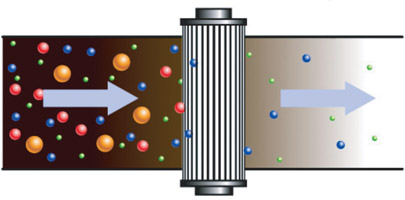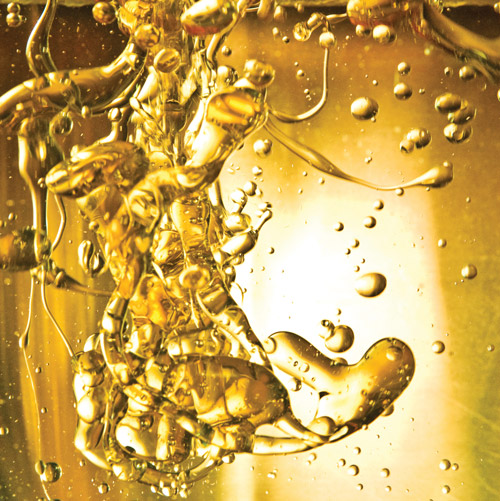Ask the Experts
Can Oil be Overfiltered?
 "We are having a discussion as to whether way lube can be overfiltered. We use 220 way oil on our mechanical presses, and the question was whether we could clean the oil too much. What is the standard way lube filtration recommendation, if there is one?"
"We are having a discussion as to whether way lube can be overfiltered. We use 220 way oil on our mechanical presses, and the question was whether we could clean the oil too much. What is the standard way lube filtration recommendation, if there is one?"
The question of whether more is always better when it comes to filtration is a common concern. The answer isn’t as simple as you might think. It has been proven that cleaner oil decreases bearing and machine wear, thus increasing equipment life expectancy. However, there are issues to consider when striving for very low ISO cleanliness codes.
One of the first things to take into consideration is the machine’s tolerances and need for clean oil. Hydraulic systems are notorious for needing clean oil, especially when compared to an industrial gearbox. That’s not to say that gearboxes don’t require clean oil. It just depends on the machine’s age, criticality and equipment cost. In other words, the fluid cleanliness should be matched to these conditions.
After determining the required machine cleanliness, you must select a filter to achieve these levels. The filter’s micron rating is commonly referred to as the benchmark of filter performance, but this only tells half the story. The beta ratio completes the picture of the filter’s true performance and capability. While the micron rating tells you how fine or how coarse the filter media is, the beta ratio tells you how efficiently it catches particles at that micron value. For instance, while having a 3-micron filter is good, it doesn’t tell you much about the filter. It could be a 3-micron filter with a beta ratio of 2, which is only 50 percent efficient, or as high as 2,000, which is 99.999 percent efficient at the same micron value.
Some filters can actually filter at a sub-micron level. As they become more aggressive, filters can begin to strip out some additives, affecting lubricant health. For example, defoamants are among the most common additives to be filtered out, as they are quite large. Depending on the filter media, other additives may be at risk as well. If using a chemically active filter such as fuller’s earth, polar additives (extreme pressure, anti-wear, demulsifiers, etc.) can be stripped, affecting the lubricant’s additive package and ability to protect the machine’s surfaces.
While clean oil is always better, balancing the needs of the machine with the cost of cleaning the fluid can lead to greater reliability and fewer failures. Remember, when it comes to filtration, it isn’t a one-size-fits-all approach. All systems have unique requirements for cleanliness, and they should all be viewed independently.
"How do you interpret the results of DIN ISO 6614 demulsibility for turbine oils?
 "I'm checking a data sheet of a proposed lubricant's separation power of water and oil, and the test yields a value of less than 30. Is this a good result for the test?"
"I'm checking a data sheet of a proposed lubricant's separation power of water and oil, and the test yields a value of less than 30. Is this a good result for the test?"
The ability for water and oil to separate, also known as demulsibility, is an important factor in many industrial oils. The effects of water in oil can be very detrimental to machine surfaces and can greatly reduce machine life. This oil property must be closely monitored, especially in areas where water ingression is common (steam turbines, paper machines, etc.).
There are three states of water in oil: dissolved, free and emulsified. Dissolved water occurs when the molecules are dispersed one by one throughout the oil. As the amount of water in the oil increases, you begin to see emulsions, or water that is suspended in the oil, and then free water. Free water is the water that separates and settles out of the oil. It is typically found in the bottom of the sump or reservoir.
When testing for demulsibility, specific amounts of oil and water are mixed. The resulting solution is then left to separate. The results are reported in the following format: X/X/X (X). This correlates to the amount of oil/water/emulsion and time (in minutes) to reach that level of separation. The best results would be 40/40/0, with a lower number in parenthesis indicating quicker full separation. This result shows that the original 40 milliliters (ml) of oil fully separated from the 40 ml of water. As fluid ages, there tends to be a difference in these values, particularly in oils that have been contaminated with water.
Conversely, 0/0/80 would be the worst possible result. In this case, the oil and water never separate, and what is left is known as a stable emulsion. Of all states of water in oil, emulsified water is considered the most destructive. As oil flows through the system, the emulsified water flows with it and can cause increased machine damage through corrosion, impaired load-carrying capability and a long list of other issues.
A value of less than 30 means that the measured separation occurred in less than 30 minutes. Provided that the oil and water separated completely, the oil's demulsibility properties are likely still intact. The best way to know whether the results for used oil are satisfactory is to start with a good baseline. As new oils are delivered, they should be subjected to these types of tests to establish a baseline for comparison.
If you have a question for one of Noria’s experts, email it to editor@noria.com.
